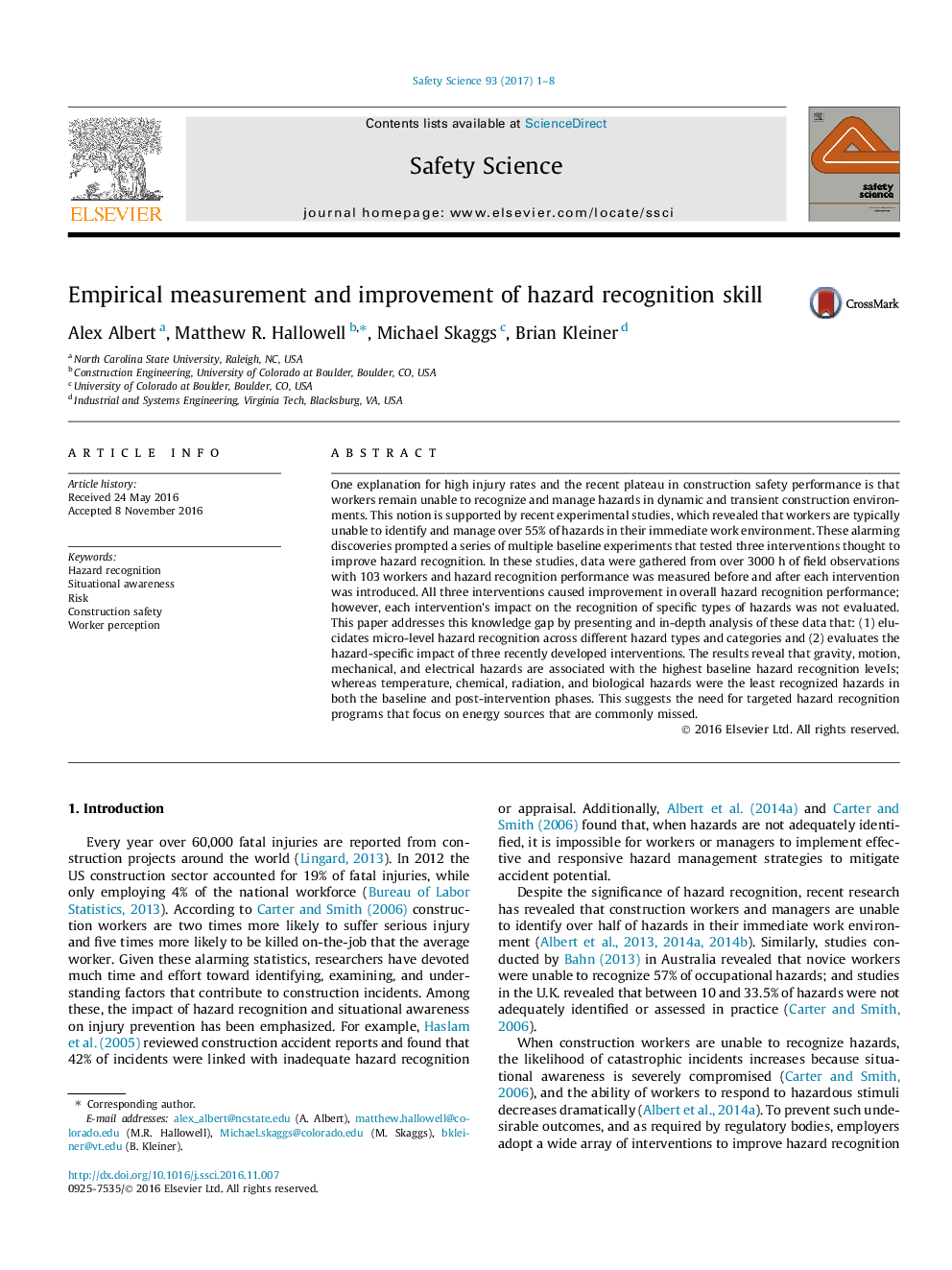| کد مقاله | کد نشریه | سال انتشار | مقاله انگلیسی | نسخه تمام متن |
|---|---|---|---|---|
| 4981271 | 1453378 | 2017 | 8 صفحه PDF | دانلود رایگان |
عنوان انگلیسی مقاله ISI
Empirical measurement and improvement of hazard recognition skill
ترجمه فارسی عنوان
اندازه گیری تجربی و بهبود مهارت شناخت خطر
دانلود مقاله + سفارش ترجمه
دانلود مقاله ISI انگلیسی
رایگان برای ایرانیان
کلمات کلیدی
شناسایی خطر، آگاهی وضعیتی، خطر، ایمنی ساختمان، ادراک کارگر،
ترجمه چکیده
یک توضیح برای میزان آسیب بالا و فلات اخیر در عملکرد ایمنی ساختمان این است که کارگران همچنان قادر به تشخیص و مدیریت خطرات در محیط های ساخت و ساز پویا و گذرا نمی باشند. این مفهوم توسط مطالعات تجربی اخیر تایید شده است که نشان می دهد که کارگران معمولا قادر به شناسایی و مدیریت بیش از 55٪ خطرات در محیط کار فوری خود نیستند. این اکتشافات هشدار دهنده، یک سری از آزمایش های مختلف مبتنی بر هسته ای را انجام دادند که سه مداخله ای را انجام دادند که به منظور تشخیص خطر بهبود یافتند. در این مطالعات، داده ها از بیش از 3000 ساعت مشاهدات میدانی با 103 کارگر جمع آوری شده و عملکرد تشخیص خطر قبل و بعد از هر مداخله اندازه گیری شد. تمام سه مداخله موجب بهبود عملکرد کلی تشخیص خطر شدند. با این حال، تاثیر هر مداخله بر شناخت انواع خطرات خاص مورد ارزیابی قرار نگرفت. این مقاله به این شکاف دانش با ارائه و تجزیه و تحلیل عمیق این داده ها اشاره می کند که: (1) شناسایی خطر در سطح میکرو در انواع مختلف و انواع مختلف خطر را توضیح می دهد و (2) تاثیر خاص خطر سه اقدام اخیر را ارزیابی می کند. نتایج نشان می دهد که خطرات گرانش، حرکت، مکانیکی و الکتریکی با بالاترین سطوح تشخیص خطر اولیه مرتبط هستند؛ در حالی که درجه حرارت، مواد شیمیایی، تابش و خطرات بیولوژیکی، خطر های کمتر شناخته شده در مراحل اولیه و پس از مداخله بود. این نشان می دهد که نیاز به برنامه های به رسمیت شناختن هدف است که بر منابع انرژی متمرکز شده که معمولا از دست رفته اند.
موضوعات مرتبط
مهندسی و علوم پایه
مهندسی شیمی
بهداشت و امنیت شیمی
چکیده انگلیسی
One explanation for high injury rates and the recent plateau in construction safety performance is that workers remain unable to recognize and manage hazards in dynamic and transient construction environments. This notion is supported by recent experimental studies, which revealed that workers are typically unable to identify and manage over 55% of hazards in their immediate work environment. These alarming discoveries prompted a series of multiple baseline experiments that tested three interventions thought to improve hazard recognition. In these studies, data were gathered from over 3000 h of field observations with 103 workers and hazard recognition performance was measured before and after each intervention was introduced. All three interventions caused improvement in overall hazard recognition performance; however, each intervention's impact on the recognition of specific types of hazards was not evaluated. This paper addresses this knowledge gap by presenting and in-depth analysis of these data that: (1) elucidates micro-level hazard recognition across different hazard types and categories and (2) evaluates the hazard-specific impact of three recently developed interventions. The results reveal that gravity, motion, mechanical, and electrical hazards are associated with the highest baseline hazard recognition levels; whereas temperature, chemical, radiation, and biological hazards were the least recognized hazards in both the baseline and post-intervention phases. This suggests the need for targeted hazard recognition programs that focus on energy sources that are commonly missed.
ناشر
Database: Elsevier - ScienceDirect (ساینس دایرکت)
Journal: Safety Science - Volume 93, March 2017, Pages 1-8
Journal: Safety Science - Volume 93, March 2017, Pages 1-8
نویسندگان
Alex Albert, Matthew R. Hallowell, Michael Skaggs, Brian Kleiner,
